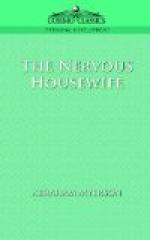And the housewife we are trying to understand is particularly such a creature, with a host of deenergizing influences playing on her, buffeting her. Our aim will be to analyze these influences and to discover how they work.
I have stated that in medical practice two other types are described,—psychasthenia and hysteria. These are not so definitely related to the happenings of life as to the inborn disposition of the patient. Nor are they quite so common in the housewife as the neurasthenic, deenergized state. However, they are usually of more serious nature, and as such merit a description.
By the term psychasthenia is understood a group of conditions in which the bodily symptoms, such as fatigue, sleeplessness, loss of appetite, etc., are either not so marked as in neurasthenia, or else are overshadowed by other, more distinctly mental symptoms.
These mental symptoms are of three main types. There is a tendency to recurring fears,—fears of open places, fears of closed places, fear of leaving home, of being alone, fear of eating or sleeping, fear of dirt, so that the victim is impelled continually to wash the hands, fear of disease—especially such as syphilis—and a host of other fears, all of which are recognized as unreasonable, against which the victim struggles but vainly. Sometimes the fear is nameless, vague, undifferentiated, and comes on like a cloud with rapid heartbeat, faint feelings, and a sense of impending death. Sometimes the fear is related to something that has actually happened, as, fear of anything hot after a sunstroke; or fear of any vehicle after an automobile accident.
There is also a tendency to obsessive ideas and doubts; that is, ideas and doubts that persist in coming against the will of the patient, such as the obscene word or phrase that continually obtrudes itself on a chaste woman, or the doubt whether one has shut the door or properly turned off the gas. Of course, everybody has such obsessions and doubts occasionally, but to be psychasthenic about it is to have them continually and to have them obtrude themselves into every action. In extreme psychasthenia the difficulty of “making up the mind”, of deciding, becomes so great that a person may suffer agonies of internal debate about crossing the street, putting on his clothes, eating his meals, doing his work, about every detail of his coming, going, doing, and thinking. A restless anxiety results, a fear of insanity, an inefficiency, and an incapacity for sustained effort that results in the name that is often applied,—“anxiety neurosis.”
Third, there is a group of impulsions and habits. Citing a few absurd impulsions: a person feels compelled to step over every crack, to touch the posts along his journey, to take the stairs three steps at a time. The habits range from the queer desire to bite one’s nails to the quick that is so common in children and which persists in the psychasthenic adult, to the odd grimaces and facial contortions, blinking eyes and cracking joints of the inveterate ticquer. Against some of these habit spasms, comparable to severe stammering, all measures are in vain, for there seems to be a queer pleasure in these acts against which the will of the patient is powerless.




